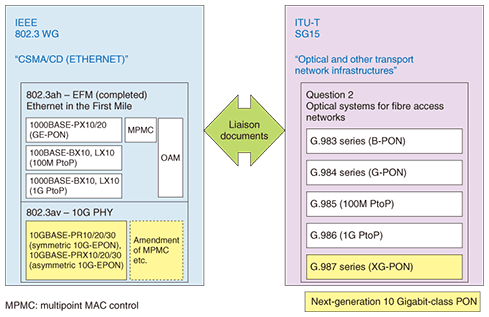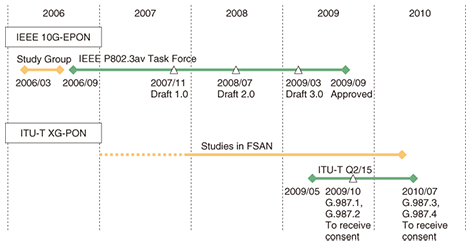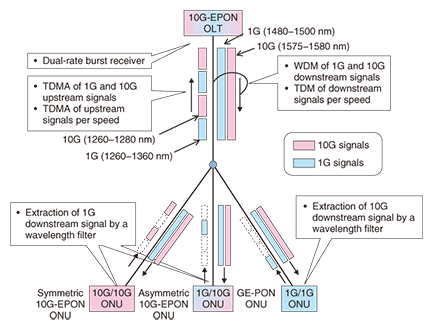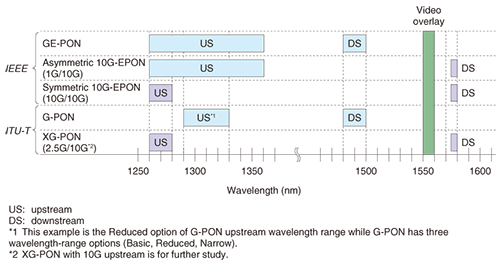 |
|||||||||||||
|
|
|||||||||||||
|
Global Standardization Activities Vol. 7, No. 11, pp. 48–53, Nov. 2009. https://doi.org/10.53829/ntr200911gls Standardization Trends of Next-generation 10 Gigabit-class Passive Optical Network SystemsAbstractThis article introduces the latest status of 10 Gigabit-class PON systems. The passive optical network (PON) is an optical access system for providing broadband access services over fiber to the home (FTTH) cost effectively. PON systems with bitrates of around 1 Gbit/s were standardized around 2004 and have supported the spread of FTTH in recent few years. Standardization activities for 10 Gigabit-class PON systems are now progressing towards the next generation.
1. IntroductionWhile the current major deployment of passive optical network (PON) systems in the world uses Gigabit-class PON systems such as Gigabit Ethernet PON (GE-PON) and Gigabit-capable PON (G-PON), standardization bodies are preparing 10 Gigabit-class PON systems for the next generation. This article first overviews PON standardization activities and then describes the features of the 10 Gigabit Ethernet PON (10G-EPON) standard as well as plans for 10 Gigabit-capable PON (XG-PON) standardization. 2. Overview of PON standardizationThe structure of PON system standardization, including the latest activities for next-generation 10 Gigabit-class PON systems, is shown in Fig. 1. The IEEE 802.3 Working Group (WG) [1], which is a traditional group that developed the specifications for Ethernet, started standardization of the Ethernet-based PON system with a bitrate of 1 Gbit/s (i.e., GE-PON) in 2001 in the “Ethernet in the First Mile (EFM)” Task Force (TF) through the development of IEEE Standard 802.3ah (completed in 2004). The PON system in general is a point-to-multipoint optical communication system in which an optical line terminal (OLT) communicates with multiple optical network units (ONUs) via one or more passive optical splitters: in the GE-PON case, the ONUs share the total bandwidth of 1 Gbit/s [2]. The EFM TF defined physical layer specifications for GE-PON (as 1000BASE-PX10, PX20), multipoint media access control (MAC) functions for PON, operation, administration and maintenance (OAM) functions for subscriber access networks, as well as physical layer specifications for 100 Mbit/s and 1 Gbit/s point-to-point optical access systems (as 100BASE-BX10, LX10, 1000BASE-BX10, LX10). Here, PX, BX, and LX represent PON, single-fiber point-to-point, and dual-fiber point-to-point, respectively, while 10 and 20 represent the 10- and 20-km versions, respectively. GE-PON utilizes MAC frames for data transfer in the PON section.
In 2006, the IEEE 802.3 WG set up “10Gb/s PHY for EPON” TF and started a study of physical layer specifications to achieve the 10G-EPON through the development of IEEE Standard 802.3av. The work has been completed in 2009 with the definition of 10GBASE-PR10, 20, 30 for 10G/10G (upstream/downstream; G denotes approximately 1 Gbit/s) systems and 10G/1GBASE-PRX10, 20, 30 for 1G/10G systems. Note that here 30 represents the 20-km version with an increased power budget rather than a 30-km version. In the ITU-T (International Telecommunication Union, Telecommunication Standardization Sector), optical access systems are studied in Question 2 of Study Group 15 (Q2/15). Study Group 15 (SG15) studied and standardized the Broadband PON (B-PON, ITU-T Recommendation G.983 series), whose bitrate is 155–622 Mbit/s, by 2001, as well as Gigabit-capable PON (G-PON, ITU-T Recommendation G.984 series), whose upstream/downstream bitrates are 1.25/2.5 Gbit/s, from 2002 to 2004. B-PON and G-PON utilize asynchronous transfer mode (ATM) frames and GTC (G-PON Transmission Convergence) frames for data transfer in the PON sections, respectively. ITU-T Q2/15 has started standardizing XG-PON (where X stands for the Roman number 10, i.e., XG-PON means 10G-PON) as the successor to G-PON. The timeline for the standardization of IEEE 10G-EPON and ITU-T XG-PON is shown in Fig. 2. ITU-T plans to achieve consent for four Recommendations, G.987.1 to G.987.4, from 2009 to 2010 (technical details are explained in Section 4). As for ITU-T B-PON and G-PON, the Full Service Access Network Initiative (FSAN) [4] conducted technical studies and proposed the results in ITU-T. FSAN has also been studying XG-PON since around 2007.
3. IEEE 10G-EPONThe 10G-EPON standardization (as IEEE Std 802.3av) was started with the target limited to adding the 10-Gbit/s physical layer specifications to the GE-PON standard specifications. However, a smooth system upgrade from GE-PON was later added to the target because widespread deployment of GE-PON had already started at that time. Some necessary amendments to the other layers (MAC layer and above) to accommodate the new physical layer specifications as well as to achieve a smooth system upgrade have also been accepted. To achieve a smooth upgrade, it is assumed in the 10G-EPON standard that the following three types of ONUs can coexist in the same PON. (1) Symmetric 10G-EPON ONU (10G/10G), (2) Asymmetric 10G-EPON ONU (1G/10G), (3) GE-PON ONU (1G/1G). The scheme for achieving this is shown in Fig. 3. 1G/10G signals are transmitted in different wavelength bands (i.e., 1480–1500 nm upstream and 1575–1580 nm downstream) at the OLT, and the ONU selects one signal or the other by using a wavelength filter: this process is called wavelength-division multiplexing (WDM). 1G/10G signals are transmitted within the same/overlapped wavelength band (1260–1360 upstream and 1260–1280 nm downstream) at ONUs, but the upstream signal from each ONU is transmitted so as to arrive at the OLT at a different timing from those of the others under the OLT’s control: this scheme is called time-division multiple access (TDMA). To receive consecutive upstream signals having different speeds (i.e., 1G or 10G) and different powers from each other, a dual-rate burst receiver is necessary in OLT. The 10G-EPON standard includes the dual-rate receiver implementation as an Annex.
The wavelength allocations of GE-PON, asymmetric 10G-EPON, and symmetric 10G-EPON are summarized in the upper part of Fig. 4. As shown in this figure, radio-frequency (RF) video overlay onto PON (using 1550–1560 nm) [5] is considered in 10G-EPON as well as in GE-PON.
10G-EPON uses a high-gain forward error correction (FEC) code, called Reed-Solomon (255, 223), to make possible low-cost optical transceiver modules. Aside from the physical layer specifications, specifications for achieving the following features are included in the standard.
The coexistence of 10G-EPON and GE-PON can be achieved by utilizing these specifications as well as a dual-rate dynamic bandwidth allocation algorithm, which is out of the scope of the standard, so that network operators can smoothly upgrade PON systems. 4. ITU-T XG-PONITU-T Q2/15 is studying XG-PON with the focus on 2.5 Gbit/s upstream and 10 Gbit/s downstream at this moment. It is planning to develop four Recommendations (G.987.1 to G.987.4), as mentioned in Section 1. Their provisional titles and contents are summarized in Table 1. A tentative overview of G.987.1 to G.987.4 is given below.
G.987.1 “XG-PON: general requirements” describes requirements for services, interfaces to other systems, and scalability such as distance and split ratio, for the purpose of serving as guidelines to G.987.2 to G.987.4. For the service requirements, the following items are under discussion: high-speed Internet access, emulation and/or simulation of legacy services, IPTV (Internet protocol television), and mobile backhauling (which requires time synchronization between the OLT and ONU). Smooth migration from the Gigabit-class PON is one of the important requirements as well. The maximum optical loss between the OLT and ONU, i.e., the loss budget, is being discussed on the basis of the existing fiber infrastructure that many network operators have already deployed for the current-generation PON. G.987.2 “XG-PON: Physical Media Dependent (PMD) layer specification” specifies various parameters of optical signals transmitted and received between the OLT and ONU as well as optical-path characteristics between them. The maximum reach between the OLT and ONU is 20 km, and its extension to 60 km is to be added in a revised version. The wavelength allocation of XG-PON is shown in the bottom line of Fig. 4: the same allocation as IEEE 10G-EPON has been selected (i.e., 1260–1280 nm upstream and 1575–1580 nm downstream), so that the optical components can be common with IEEE 10G-EPON ones and smooth migration from the Gigabit-class PON is ensured. The G-PON wavelength allocation, defined in ITU-T G.984.5, is shown above the XG-PON wavelength allocation in Fig. 4 (1290–1330 nm upstream and 1480–1500 nm downstream; note that the upstream range is for the case of the most popular Reduced option). This wavelength allocation allows XG-PON and G-PON to coexist in the same fiber when WDM is used because there are no wavelength overlaps between XG-PON and G-PON. As with IEEE 10G-EPON discussions, the issue of how to implement FEC to achieve a high loss budget is also one of the important issues under study. G.987.3 “XGPON Transmission Convergence layer specification” will define the frame structure for accommodating various client protocols, the TDMA function for controlling upstream signal timeslots, the function for activating ONUs, the function for encrypting downstream signals, and so on. How to extend the GTC frame structure to XG-PON is one of the key issues. G.987.4 “XG-PON: ONU management and control interface specification (OMCI)” will define the protocol and message formats of the management information base for managing/controlling XG-PON ONUs. Because many G-PON OMCI definitions can be applied to XG-PON, generalizing OMCI to various PON systems is under discussion. 5. SummaryThis article introduced the standardization trends of 10 Gigabit-class PON systems regarded as the successors of the Gigabit-class PON systems that support current FTTH services. The standardization of IEEE 10G-EPON and ITU-T XG-PON is being conducted through active exchanges of liaison documents (see Fig. 1). This cooperation is expected to lead to greater value in both standards. References
|
|||||||||||||














